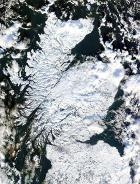
|
Detecting how climate change affects snowfall in Scotland |
|
Using remote sensing |
|
Snowy events like those of winter 2010 in Scotland (imaged by NASA’s Terra Satellite) may soon be a thing of the past. Image courtesy of Deadlines Scotland. |
|
Climate Change and Snowfall in Scotland |
|
WHAT IS CLIMATE CHANGE? Climate change or global warming refers to the temperature of the earth rising due to the man-made increase of gases like carbon dioxide, which trap the heat from the sun in the atmosphere. Globally, the effects of this warming have been seen in the melting of glaciers and the polar ice caps as well as increasing sea levels. These global changes affect continents and their nation-states in specific ways.
CLIMATE CHANGE IN SCOTLAND Scotland is in what is referred to as a “maritime climate,” known for little variation in temperature and regularly falling precipitation year round. Climate change in Scotland means more extreme weather events. Summers will be hotter and drier. Winters will be warmer but also much rainier than ever before, with far fewer days of snow and frost.
EFFECTS ON SNOWFALL Snowfall and snow cover in Scotland have been reducing steadily since 1961, as can be seen here. Snowfall is expected to reduce by as much as 50% by 2080 with a possible reduction of up to 90% in some areas, according to the Scottish Climate Change Impacts Partnership (SCCIP). The effects of this change to the climate have already been felt.
ECOSYSTEMS Some highland corries (deep hollows in hillsides) used to have nearly permanent snowbeds that were home to liverworts and mosses rare to the island. With changing weather patterns, these corries are now often bare of snow. This changing environment has lead to an influx of flowering plants which previously could not have survived in the snowbeds. These changing ecosystems are a direct threat to birds that live off the insects of snowbed plant life. Also, the lack of snow makes the highlands more accessible for more of the year, meaning trampling of terrain is likely from the increased human presence.
WINTER TOURISM Some area ski resorts have already had to close their doors due to the lack of snow. Snow-covered mountains will remain, but only in remote, hard to access areas and with increased chances of avalanches, according to this climate change report. A few ski resorts have attempted to temper the effects of the lack of snow with ecologically ill-advised solutions like snow-making machines or a controversial funicular.
|
|
Francesca Runciman Salem State University Geography Department GPH909—Introduction to Remote Sensing with Dr. Stephen Young Last Updated 12/06/10 |
|
Website created by: |
|
Phone: 978-542-6225 Fax: 978-542-6269 E-mail: geography@salemstate.edu |

